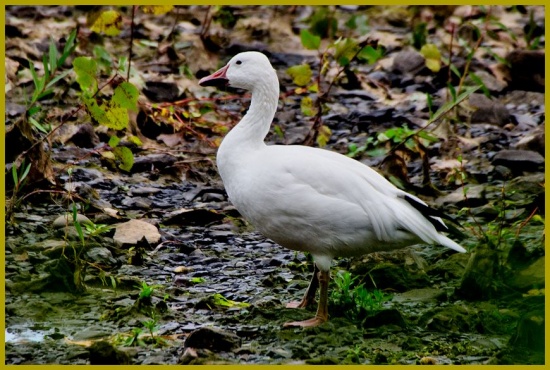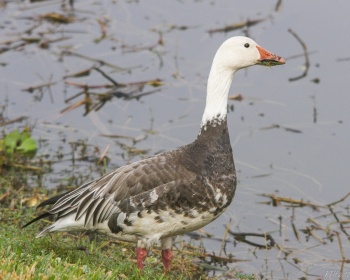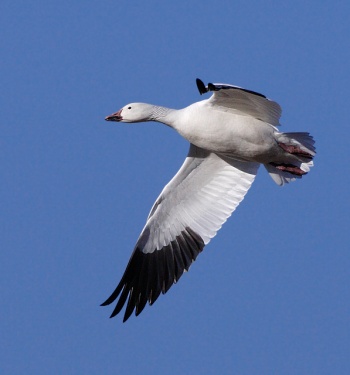(genus change) |
(→External Links: Multiple GSearches combined) |
||
| (11 intermediate revisions by 3 users not shown) | |||
| Line 1: | Line 1: | ||
| − | [[Image: | + | [[Image:Snowgoose645510-5-12.jpg|thumb|550px|right|Photo © by {{user|gophish|gophish}}<br />Cohoes, [[New York]], [[United States]] 5 October, 2012]] |
;[[:Category:Anser|Anser]] caerulescens | ;[[:Category:Anser|Anser]] caerulescens | ||
==Identification== | ==Identification== | ||
| − | *Entirely white except black primaries | + | [[Image:Snow Goose blue morph 12-9-2012 1 of 1 .jpg|thumb|350px|right|Adult, blue morph<br />Photo © by {{user|Pauhana|Pauhana}}<br />Twin Lakes, Brandon, [[Florida]], [[United States]],<br /> 9 December 2012]] |
| + | 66–84 cm (26-33 in) | ||
| + | *Entirely white except black [[Topography#Wings|primaries]] | ||
*Head and neck usually stained rusty brown | *Head and neck usually stained rusty brown | ||
*Pink bill with grin patch | *Pink bill with grin patch | ||
| Line 9: | Line 11: | ||
Separating from [[Ross's Goose]] - Snow Goose has longer neck and bill. Ross's Goose has short neck and stubby bill that lacks grin patch. | Separating from [[Ross's Goose]] - Snow Goose has longer neck and bill. Ross's Goose has short neck and stubby bill that lacks grin patch. | ||
==Distribution== | ==Distribution== | ||
| − | |||
Extreme northern [[Arctic]] in summer. Winters in Southern [[U.S.]] and [[Mexico]], notably along coasts, but also at inland marshy reserves. | Extreme northern [[Arctic]] in summer. Winters in Southern [[U.S.]] and [[Mexico]], notably along coasts, but also at inland marshy reserves. | ||
==Taxonomy== | ==Taxonomy== | ||
| + | [[File:Snow_Goose_2_CT.jpg|thumb|350px|right|Juvenile <br />Photo © by {{user|Craig+Thayer|Craig Thayer}}<br />Green Valley, [[Arizona]], 31 December 2020]] | ||
| + | |||
| + | Formerly placed in the genus ''[[:Category:Chen|Chen]]''. | ||
| + | ====Subspecies==== | ||
There are two recognized subspecies.<sup>[[#References|[1]]]</sup> | There are two recognized subspecies.<sup>[[#References|[1]]]</sup> | ||
*''A. c. caerulescens'' | *''A. c. caerulescens'' | ||
| Line 18: | Line 23: | ||
*''A. c. atlanticus'' | *''A. c. atlanticus'' | ||
**Breeds and winters on land bordering western Atlantic Ocean | **Breeds and winters on land bordering western Atlantic Ocean | ||
| − | |||
==Habitat== | ==Habitat== | ||
| − | Nests | + | [[Image:86211-10-05 107.jpg|thumb|350px|right|Photo © by {{user|richard+bledsoe|richard bledsoe}}<br />[[New Mexico]], [[USA]], 10 November 2005]] |
| + | Nests on Arctic tundra in large colonies. Migrates southward in winter to marshy areas with adjacent fields. | ||
==Behaviour== | ==Behaviour== | ||
Highly gregarious; nest, migrate, and forage in large flocks. Noisy, especially on takeoff. Fly in large V formations. | Highly gregarious; nest, migrate, and forage in large flocks. Noisy, especially on takeoff. Fly in large V formations. | ||
| + | ====Diet==== | ||
| + | [[Image:Snow Goose juvenile Blue goose .jpg|thumb|350px|right|Juvenile, dark morph<br />Photo © by {{user|Stanley+Jones|Stanley Jones}}<br />Hagerman National Wildlife Refuge, Grayson County, [[Texas]], [[USA]], 17 November 2017]] | ||
| + | Their diet is mainly vegetarian, consisting of roots, tubers, leaves, grasses, stems and seed heads from a variety of aquatic plants. They also eat grain in the winter time. | ||
| + | ====Movements==== | ||
| + | |||
| + | Migratory. | ||
==References== | ==References== | ||
| − | #{{Ref- | + | #{{Ref-Clements6thAug19}}#Mowbray, T. B., F. Cooke, and B. Ganter (2020). Snow Goose (Anser caerulescens), version 1.0. In Birds of the World (P. G. Rodewald, Editor). Cornell Lab of Ornithology, Ithaca, NY, USA. https://doi.org/10.2173/bow.snogoo.01 |
| + | #BF Member Observations | ||
| + | |||
{{ref}} | {{ref}} | ||
==External Links== | ==External Links== | ||
| − | {{GSearch|Snow | + | {{GSearch|"Anser caerulescens" {{!}} "Snow Goose"}} |
| + | {{GS-checked}} | ||
| + | <br /> | ||
<br /> | <br /> | ||
| − | + | ||
| − | [[Category:Birds]][[Category:Anser | + | [[Category:Birds]][[Category:Anser]] |
Latest revision as of 22:34, 22 December 2022
- Anser caerulescens
Identification
66–84 cm (26-33 in)
- Entirely white except black primaries
- Head and neck usually stained rusty brown
- Pink bill with grin patch
- Dark adults have black bodies with white necks and heads, juveniles dark all over. All intermediates possible.
Similar Species
Separating from Ross's Goose - Snow Goose has longer neck and bill. Ross's Goose has short neck and stubby bill that lacks grin patch.
Distribution
Extreme northern Arctic in summer. Winters in Southern U.S. and Mexico, notably along coasts, but also at inland marshy reserves.
Taxonomy
Formerly placed in the genus Chen.
Subspecies
There are two recognized subspecies.[1]
- A. c. caerulescens
- Breeds and winters around the Pacific Ocean
- A. c. atlanticus
- Breeds and winters on land bordering western Atlantic Ocean
Habitat
Nests on Arctic tundra in large colonies. Migrates southward in winter to marshy areas with adjacent fields.
Behaviour
Highly gregarious; nest, migrate, and forage in large flocks. Noisy, especially on takeoff. Fly in large V formations.
Diet

Photo © by Stanley Jones
Hagerman National Wildlife Refuge, Grayson County, Texas, USA, 17 November 2017
Their diet is mainly vegetarian, consisting of roots, tubers, leaves, grasses, stems and seed heads from a variety of aquatic plants. They also eat grain in the winter time.
Movements
Migratory.
References
- Clements, J. F., T. S. Schulenberg, M. J. Iliff, S. M. Billerman, T. A. Fredericks, B. L. Sullivan, and C. L. Wood. 2019. The eBird/Clements Checklist of Birds of the World: v2019. Downloaded from http://www.birds.cornell.edu/clementschecklist/download/
- Mowbray, T. B., F. Cooke, and B. Ganter (2020). Snow Goose (Anser caerulescens), version 1.0. In Birds of the World (P. G. Rodewald, Editor). Cornell Lab of Ornithology, Ithaca, NY, USA. https://doi.org/10.2173/bow.snogoo.01
- BF Member Observations
Recommended Citation
- BirdForum Opus contributors. (2024) Snow Goose. In: BirdForum, the forum for wild birds and birding. Retrieved 9 May 2024 from https://www.birdforum.net/opus/Snow_Goose
External Links
GSearch checked for 2020 platform.







